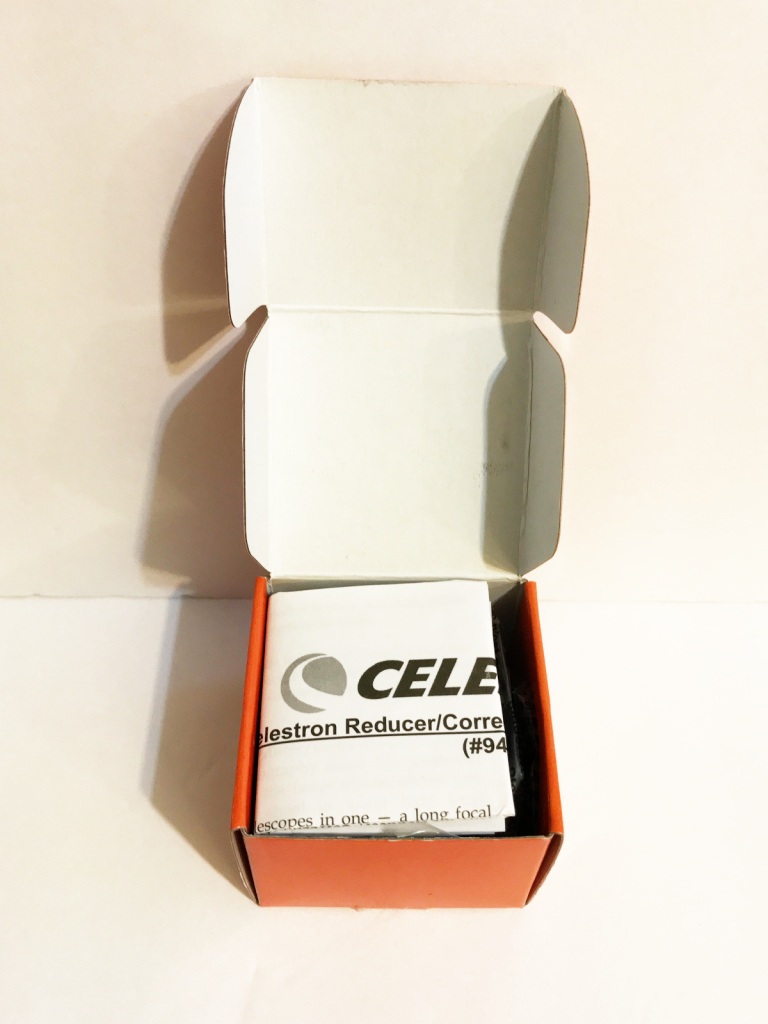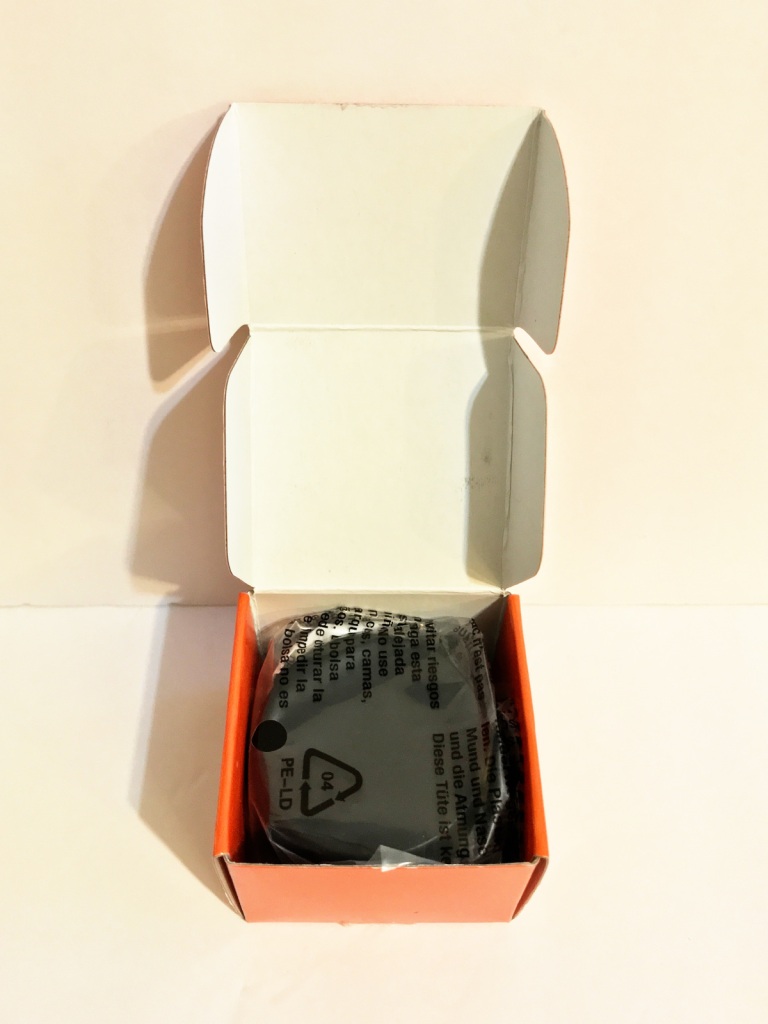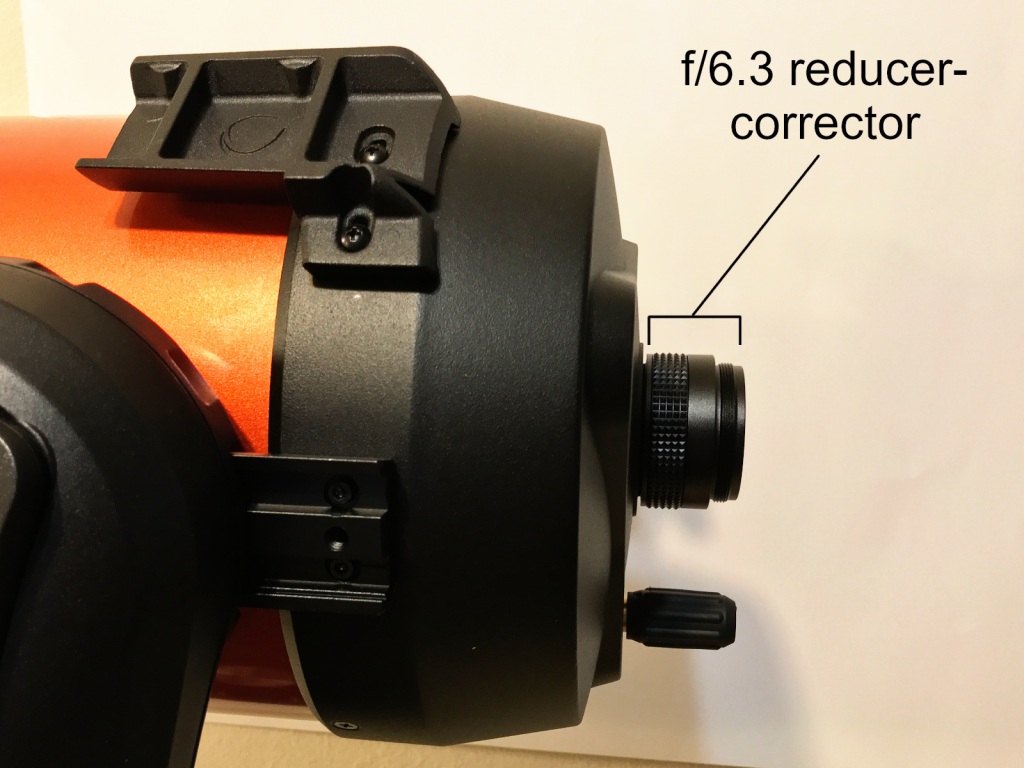
Unboxing fest, part 2: Celestron f/6.3 focal reducer-corrector
October 3, 2020
Even before I had decided to get the NexStar 8SE, I knew that if I got a big SCT, I’d want a focal reducer-corrector for it. SCTs and Maks have secondary mirrors, which partially obstruct incoming light. This implies a necessary tradeoff: make the central obstruction small, which results in a long focal ratio–typically f/10 to f/15 for commercially-available SCTs and Maks–or get a shorter focal ratio by using a larger secondary mirror, which blocks more light and degrades the contrast.

There is a third solution, which is to use a focal reducer to make a steeper light cone and a shorter focal ratio. Astrophotographers use these all the time to making their scopes optically ‘faster’ so they can get brighter images with shorter exposure times. For SCTs they are useful because they bring the focal length of the scope down to something more reasonable, and increase the true field of view. As shipped, the Celestron C8 OTA has a focal length of 2032mm, so even a 32mm Plossl gives 63.5x, and the included 25mm Plossl gives 81x. The max true field of view with 1.25″ eyepieces is about 0.7 degrees, which can be a little claustrophobic. You can juuust fit the Double Cluster in a 32mm Plossl, as long as you don’t mind clipping the edges of both clusters. You can get M81 and M82 at the same time, as long as you don’t mind parking them on the extreme edges of the FOV.

The Celestron f/6.3 reducer-corrector turns the C8 from an f/10 to an f/6.3, with an effective focal length of 1280mm, which is pretty close to the mid-sized commercial Dobsonians–the XT6, XT8, and XT10 and equivalent models from other companies are all 1200mm scopes. That pushes the max true field to something like 1.2 or 1.3 degrees, which is a big jump over the native 0.7 or so. That’s enough to put some of the larger celestial objects, like the Pleiades and M44, back in a single field of view, although the Pleiades will be cutting it mighty fine (I will test this and report back!).
As the name implies, this unit is not just a focal reducer, it’s also a corrector, which makes the field flatter for better image correction across the entire field of view. In other words, stars at the edge of the field should still look round with this thing in, as opposed to oblong. This isn’t a factor for me–I don’t photograph stars, and the stars at the edge of the field in the C8 haven’t bothered me so far–but it’s nice to have if either of those things change.

Here’s the gizmo, out of its (unsealed) bag, with its custom dust caps. I got mine from Astronomics (here), and evidently it was one of the last they had, because the availability listing there says “More on the way”. Amazon has it, too (link), I just like supporting brick-and-mortar telescope stores and specialized astro-gear dealers whenever I can.

Why am I bothering to do an elaborate unboxing post for such a trivial piece of gear? Mostly because it took a lot of digging for me to figure out how one was used. What I wanted was a photo essay that showed how “this part goes here, that part goes there”. When I couldn’t find one, I decided to create my own.

Here’s how the NexStar 8SE OTA comes as shipped, with a 1.25″ visual back on the rear port. When I was first getting into this, it took me forever to understand what a “visual back” was. Did it mean anything other than the bit where you stick the eyepiece or diagonal? And if not, doesn’t every telescope have one?
The answer is that not everyone sticks an eyepiece or diagonal at the back of a scope. Some people put a camera, or a spectrograph, or who knows what else. So if you are going to use the scope visually, you need a doohickey that holds the eyepiece or diagonal, and that’s the “visual back”. It was just new to me because non-SCTs aren’t generally described as having a “visual back” (some high-end astrograph refractors excluded), they just have focusers.

ANYWAY, the focal reducer-corrector threads onto the rear port of the scope, after the visual back has been removed.

Then the visual back screws into the focal reducer.

Then you put eyepieces or diagonals into the visual back, as usual. Everything is just scooted back 3/4 of an inch or so by having the focal reducer interposed between the scope and the visual back.
Incidentally, this is something to keep an eye on for NexStar users: when the scope is pointing high, the diagonal already comes pretty close to the base of the mount, depending on how far forward the OTA is scooted in the dovetail clamp. I’ll have to mess around with the system, but I might have to start mounting the scope a smidge farther forward to make sure the diagonal clears the mount when observing up high.

And here’s where the last post and this post come together: the Baader Hyperion 8-24mm clickstop zoom eyepiece, riding in an Astro-Tech dielectric diagonal, inserted in the stock 1.25″ visual back that came with the C8, screwed into the f/6.3 focal reducer-corrector. All saddled up and ready to go (er, minus the finders). Now all I need is for night to fall.
I have one more piece of gear to write about, but it hasn’t come in yet, so the next post might be an observing report–hopefully, a first-light report on the focal reducer and the Baader zoom. Stay tuned.
Ugh, don’t try the Pleiades with this. Okay, I know you’re gonna do it anyway ;-). But I’ve tried this, and they look awful. You will be able to fit them in with the reducer and a 32mm Plossl. However, they’re all crammed in with absolutely no breathing room. You need that layer of black all around them to see their setting in space and make them aesthetically pleasing.
[…] Stargazing for people who think they don't have time for stargazing. « Unboxing fest, part 2: Celestron f/6.3 focal reducer-corrector […]
Thanks, Jon. You’re right, I’m gonna try it anyway! Didn’t manage it last night, but I will one of these evenings. I agree, celestial objects need a little breathing room in the FOV to look their best. One of the things I really like about having the 9×50 finder is being able to enjoy those big sprawling objects.